Year-Over-Year Cost Comparison Dashboard
Caroline Antoun
Take a deep dive into your invoice, labor, and material cost changes with this Year-Over-Year Cost Comparison dashboard. What sets this dashboard apart is its utilization of median values instead of averaging costs, giving you a clearer and more reliable understanding of your spend over time. Cost changes are measured from the selected period and the year prior to the selected period. Filter to focus on specific types of cost, such as on-demand repairs or capital expenditures. Then quickly compare these changes by trades, providers, regions, and districts to examine what is driving cost changes.
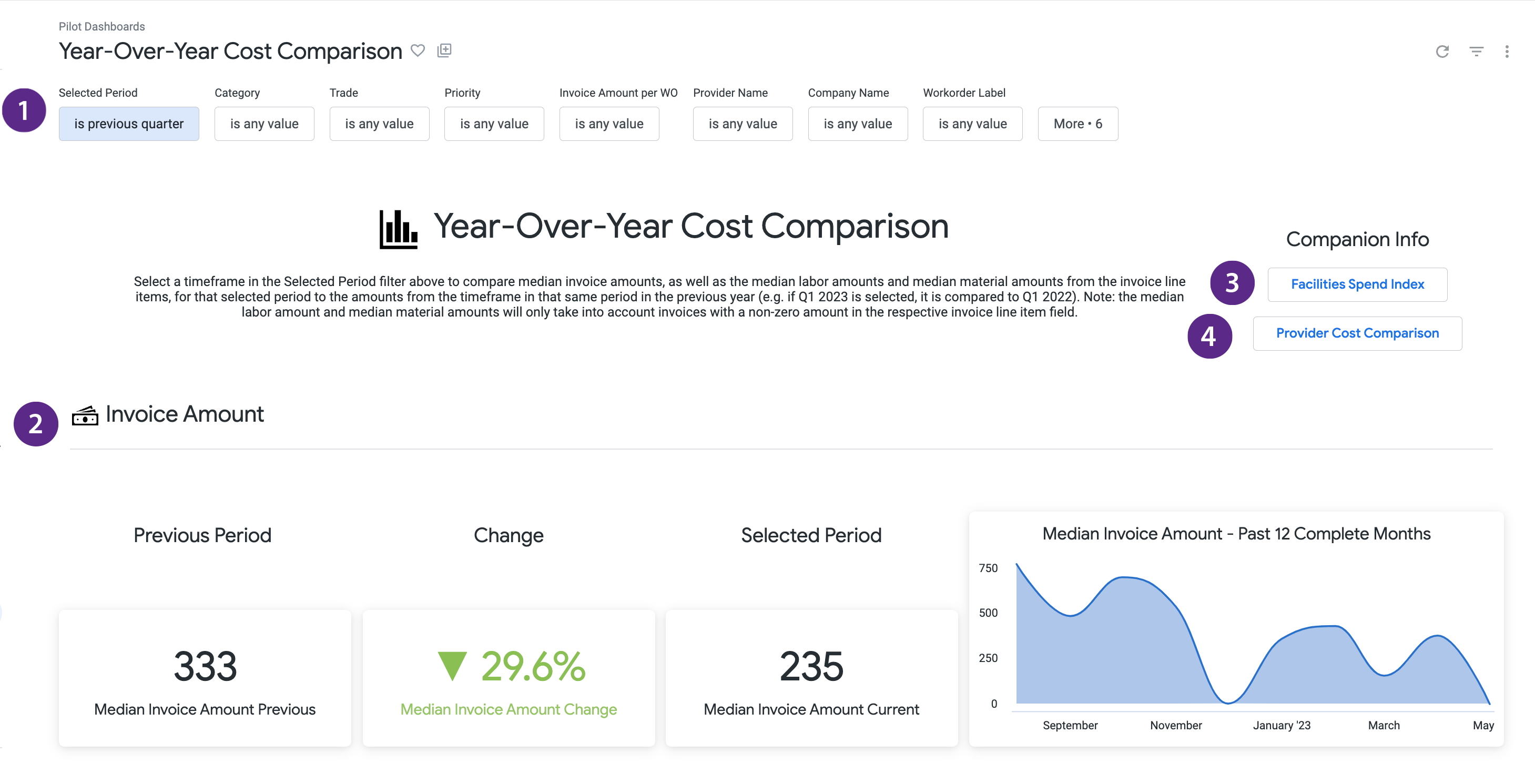
You can find this dashboard under the Standard Dashboards folder in Analytics.
Median Values
The median is the middle number in an ordered list of numbers. Half of the numbers are below it and half are above it. We use median in this dashboard instead of average to give a more representative idea of cost. Very large or low invoice amounts can skew the average, particularly as the number of data points decreases (e.g.filtering to narrow date ranges).
Line Item Invoicing
If you do not have Line Item Invoicing turned on, you will not see any data for Labor and Material Amounts. See Configuring Require Line Items to change your set-up.
Navigation
This dashboard is broken up into 4 main sections:
Filters
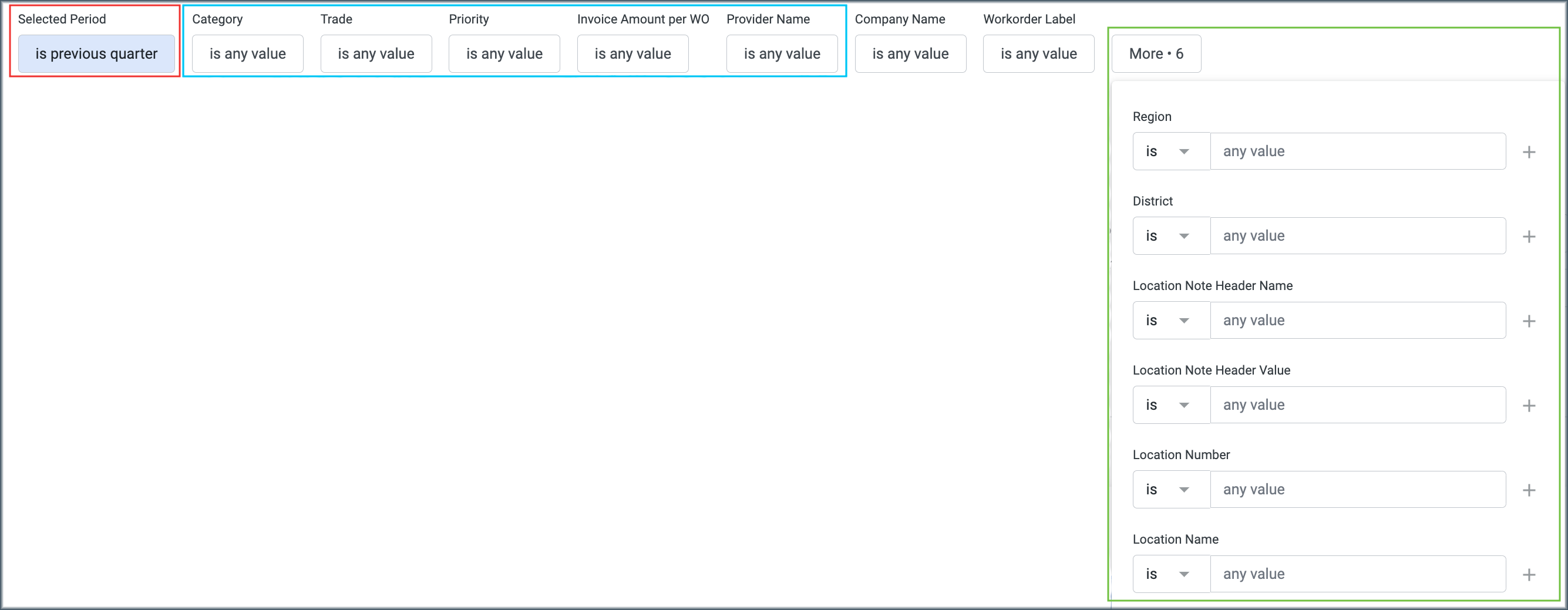
Selected Period Filter
Take special note of the Selected Period filter as it isn't like any other filter used in Analytics before.
- Selected Period
Choose the best time frame combination to compare data from that time frame to that time frame in the previous year. Ex: Today is July 10, 2023 and you choose previous month. Data shown will compare June 1-30, 2022 to June 1- 30, 2023.
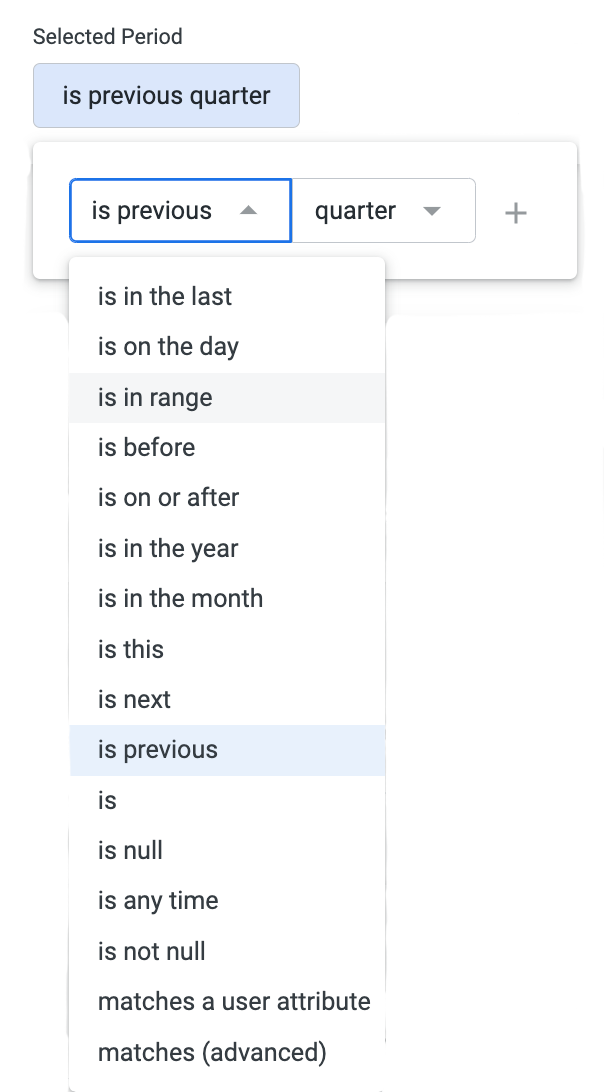

- Category / Trade / Priority / Invoice Amount per WO / Provider Name
Filter by these parameters to focus on specific types of work and costs. Category,Trade, Priority will be the primary one chosen by ServiceChannel. See Work Order Properties to view and update yours if needed.
- More + 6: Region / District / Location Note Header Name / Location Note Header Value / Location Number / Location Name
Click on More + 6 to focus your filtering on specific geographical or organizational alignments.
Looks
Invoice Amount / Labor Amount /Material Amount
These looks give two visuals to the filtered data:
- YOY look at Median Invoice Amount from Previous Period, Change Percentage, and Selected Period Median Invoice Amount
- Month-over-month trend over the last 12 complete months.

You can:
- Drill into the data on each time period to see which work orders were calculated in the YOY comparison by clicking on the number (blue box in visual above).

- Drill into the data on the Month-over-Month trend line to see calculated work orders by clicking anywhere on the line.
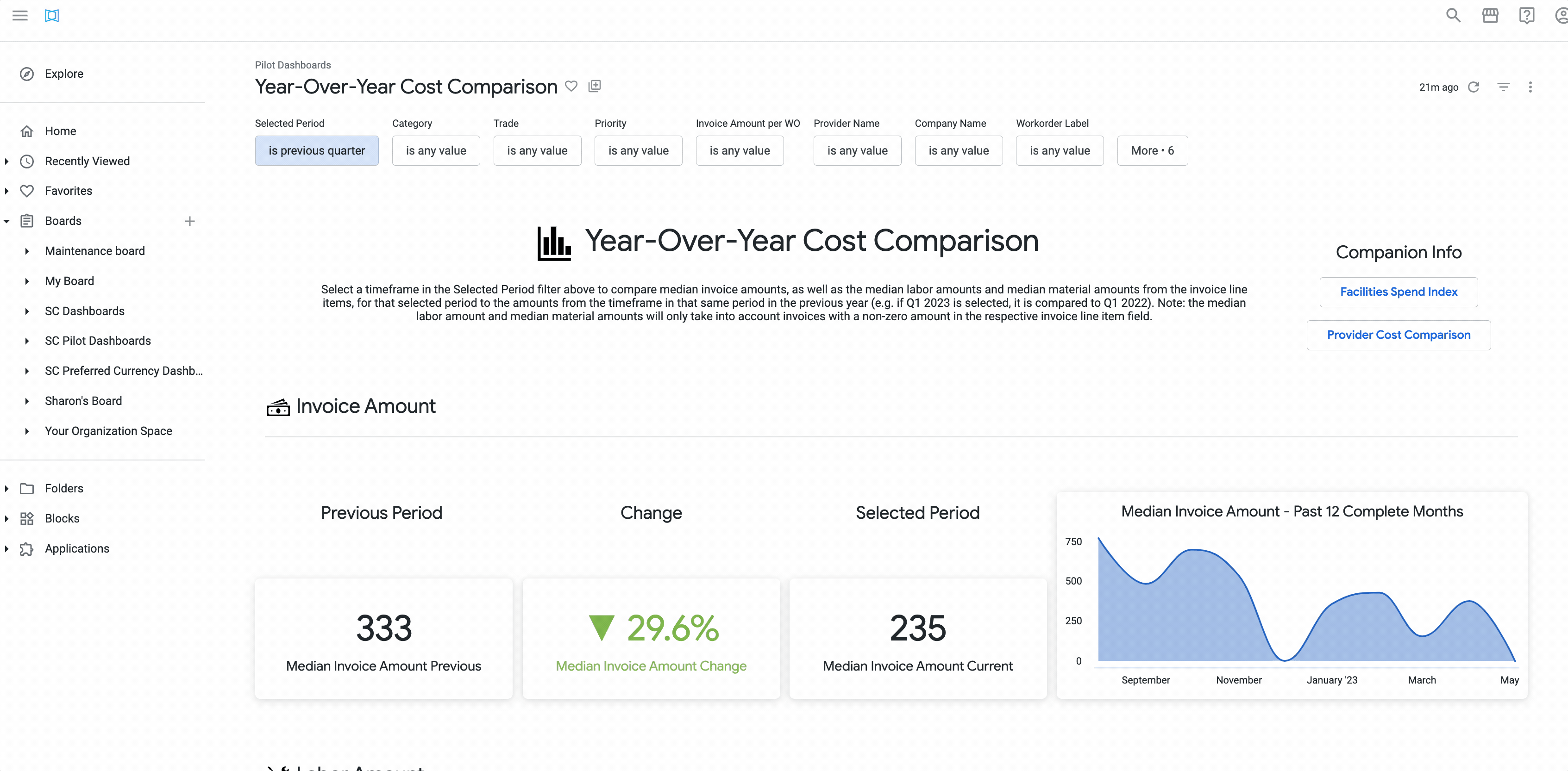
Invoice Amount
Compare the year-over-year change in the Median Invoice Amount.
In this example below, we can see last year in the month of June had a median invoice amount of $333. In June this year, there was a decrease by 29.6% with median invoice amount of $235.
Labor and Material Amount
If an invoice does not have a Labor Amount, that data will not be included in the Labor Amount data. If the invoice does not have a Material Amount, that data will not be included in the Material Amount data.
Labor Amount
Compare the year-over-year change in the Median Labor Amount for invoices that have a non-zero Labor Amount specified. If you do not have line item invoicing set up, you will not see anything here. See Configuring Require Line Items to change your set-up.
In this example below, we can see last year in the month of June had a median invoice labor amount of $132. In June this year, there was a decrease by 9.1% with median invoice amount of $120.

Material Amount
Compare the year-over-year change in the Median Material Amount for invoices that have a non-zero Material Amount specified. If you do not have line item invoicing set up, you will not see anything here. See Configuring Require Line Items to change your set-up.
In this example below, we can see last year in the month of June had a median invoice labor amount of $90. In June this year, there was an increase by 67.7% with median invoice amount of $151.

Breakdown by Trade
Compare the year-over-year change in Median Invoice Amount broken down by trade. In this example, we are still comparing June of last year with June of this year.
Breakdown by Provider
Compare the year-over-year change in Median Invoice Amount broken down by provider. In this example, we are still comparing June of last year with June of this year.

Breakdown by Region
Compare the year-over-year change in Median Invoice Amount broken down by region. In this example, we are still comparing June of last year with June of this year.
Companion Info

After using the YOY Cost Comparison dashboard, it is likely that you will want to dive further into cost. You can do that through the Facilities Spend Index and the Provider Cost Comparison dashboard.
Facilities Spend Index
The ServiceChannel Facilities Spend Index™ monitors commercial trade service costs and spending patterns based on $35 billion dollars in services delivered to 500,000 locations on the Service. Check out the Facilities Spend Index to:
› See where your budgets are growing faster than industry spend overall.
› Compare your invoice cost trends to the Service Cost Index.
› Choose between trades and regions to explore different markets.
Provider Cost Comparison
The Provider Cost Comparison dashboard can be a tool to compare individual providers within your network to the baseline of your total network’s median costs. You might find that some trade baselines have a larger cost change than others. Using this dashboard, you can filter to a trade in question and investigate whether certain providers are driving that cost change.
Commonly Used Features
Below is a quick reference guide regarding tracking numbers in Analytics, filtering, sorting, downloading data, and sending reports.
Tracking Numbers in Analytics
Throughout Analytics you can drill down into visualizations to see the underlying data. In most cases, the tracking numbers related to that data are listed. You can click the tracking number to navigate straight to the work order details in Service Automation.
Filtering Dashboards
On top of the report are all-inclusive filters to help you hone in on key data. All reports on the page are affected by the criteria set in these all-inclusive filters.
The filter criteria for each dashboard may differ. Filters reset to the default when the page is refreshed.
Click filter field to show the criteria.

Select the desired criteria to include or exclude:
To Include criteria: select is equal to, contains, starts with, or ends with, and then begin typing the criteria in the picklist. Select the desired criteria (or multiple criteria) from the picklist.
To exclude criteria: select is not equal to, does not contain, does not start with, or does not end with.
Is null depicts the absence of data in a data set. Conversely, is not null depicts the presence of data
To include or exclude data without a certain data criteria — for example, to select data without a Region or District assigned in Service Automation — choose is blank / is not blank.
To add more options, click the plus sign (+) next to a field to add another option to the filter. The new option will appear as either an OR condition or an AND condition, depending on the type of filter option.
Once all criteria are selected, click Refresh icon in the top-right corner. The Dashboard report updates with the selected criteria.
More details are available on Filtering an Analytics Dashboard
Dynamic Table Sorting
Analytics tables are dynamic, as you can:
- click column and row headers to sort data (the arrow indicate which data is sorted),
- hover over a header to show the gear icon where you can interact with the data more dynamically, and
- drag and drop a header to rearrange the table.
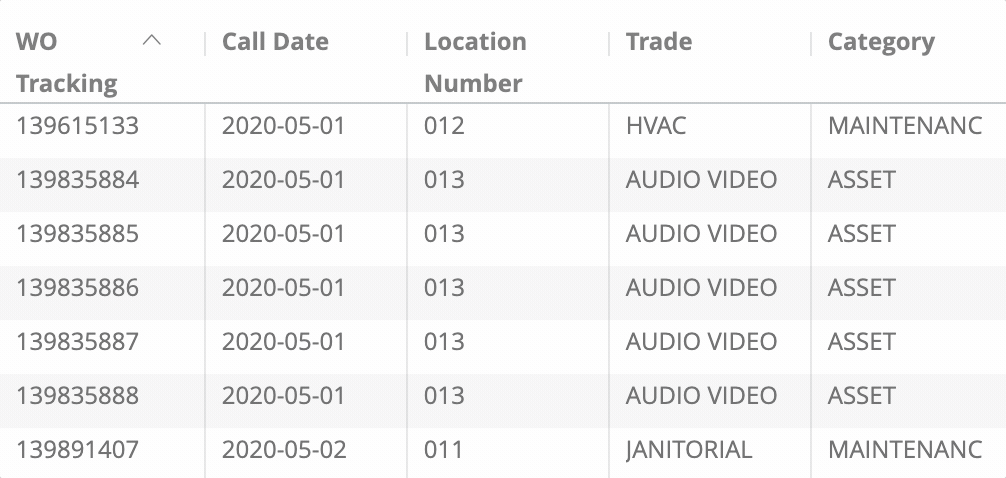
Downloading and Sending Reports
In the upper-right corner of any page, click the Vertical Ellipses to download reports, schedule delivery of reports at regular intervals, add to a board, or get a link.
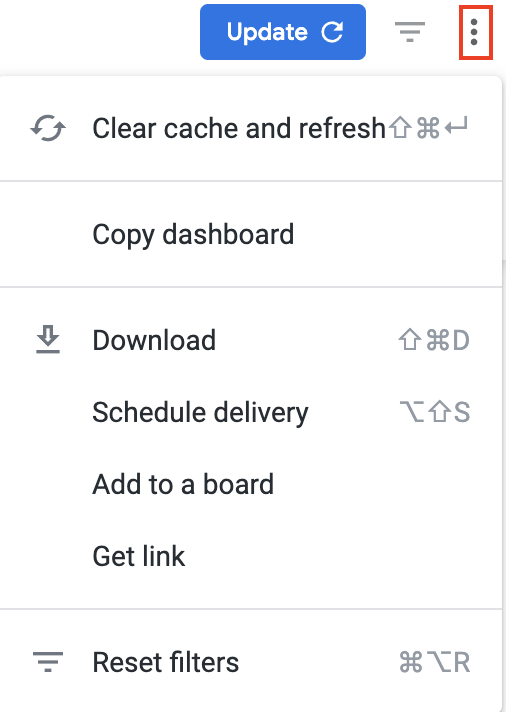
You can download data from a table and visualization or download a dashboard tabto PDF or CSV.
- On the desired table or visualization, hover over the upper-right to expose the 3 dots menu, and then click Download Data. The Download modal appears.

Select the desired File Format and choose a File Name: A default name is listed but you can change it.
- Click Download.
On the desired dashboard (or dashboard tab), click the Gear icon in the upper-right of the page, and then click Download as PDF. The Download modal appears.
A default Filename appears, but you can change it.
Under Advanced options:
Single-column format lays out all tables and visualizations on a page into one column in the PDF, as opposed to how it is laid out in the dashboard.
Expand tables shows all rows in a table, instead of just the rows that appear on the dashboard.
Paper size adjusts the PDF to your desired size.
Click Open in Browser to view the PDF in your chosen browser, or click Download to save a version of the report onto your device.
On the desired dashboard (or dashboard tab), click the Gear icon in the upper-right of the page, and then click Download as CSVs... A new browser tab opens.
After the files render, you are prompted to save the CSV Zip file onto your device.
More details are available on Downloading and Sending Dashboards and Reports
You can also Send a one-time report via email or Schedule a recurring email send.
On the desired dashboard (or dashboard tab), click the Gear icon in the upper-right of the page, and then click Send. The Send (Dashboard Name) modal opens.
A Title is given by default, but you can change it.
Under Who should it be emailed to?, enter the desired recipient(s), separated by a comma, and then click Add.
(Optional) Click Include a custom message to add a personal note.
Under Format data as, choose PDF, Visualization, or CSV Zip file.
(Optional): Click Filters to limit the criteria that appear in the email. Note that the same filters on the dashboard itself will also appear here.
Click Send. The email is sent to your recipients.
On the desired dashboard (or dashboard tab), click the Gear icon in the upper-right of the page, and then click Schedule. The Schedule (Dashboard Name) modal opens.
A Title is given by default, but you can change it.
Under Who should it be emailed to?, enter the desired recipient(s), separated by a comma, and then click Add.
(Optional) Click Include a custom message to add a personal note.
Under Format data as, choose PDF, Visualization, or CSV Zip file.
Under Deliver this schedule, choose Daily, Weekly, Monthly, Hourly, or By minute (in 5-minute increments, up to 30 minutes)
(Optional): Use Filters to limit the criteria that appear in the email. Note that the same filters on the dashboard itself will also appear here.
Click Send. The email is sent to your recipients.
More details are available on Downloading and Sending Dashboards and Reports







